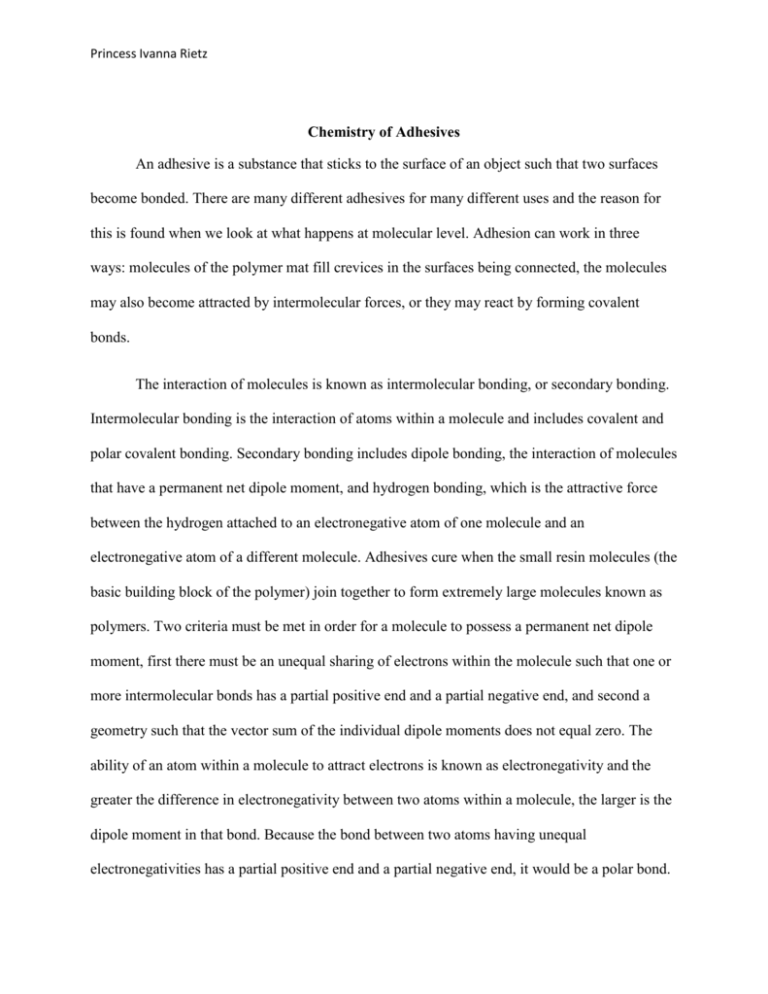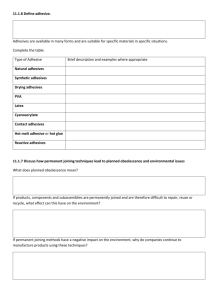Chemistry of Adhesives
advertisement

Princess Ivanna Rietz Chemistry of Adhesives An adhesive is a substance that sticks to the surface of an object such that two surfaces become bonded. There are many different adhesives for many different uses and the reason for this is found when we look at what happens at molecular level. Adhesion can work in three ways: molecules of the polymer mat fill crevices in the surfaces being connected, the molecules may also become attracted by intermolecular forces, or they may react by forming covalent bonds. The interaction of molecules is known as intermolecular bonding, or secondary bonding. Intermolecular bonding is the interaction of atoms within a molecule and includes covalent and polar covalent bonding. Secondary bonding includes dipole bonding, the interaction of molecules that have a permanent net dipole moment, and hydrogen bonding, which is the attractive force between the hydrogen attached to an electronegative atom of one molecule and an electronegative atom of a different molecule. Adhesives cure when the small resin molecules (the basic building block of the polymer) join together to form extremely large molecules known as polymers. Two criteria must be met in order for a molecule to possess a permanent net dipole moment, first there must be an unequal sharing of electrons within the molecule such that one or more intermolecular bonds has a partial positive end and a partial negative end, and second a geometry such that the vector sum of the individual dipole moments does not equal zero. The ability of an atom within a molecule to attract electrons is known as electronegativity and the greater the difference in electronegativity between two atoms within a molecule, the larger is the dipole moment in that bond. Because the bond between two atoms having unequal electronegativities has a partial positive end and a partial negative end, it would be a polar bond. Princess Ivanna Rietz Like the geometry for a water molecule is nonsymmetrical (the electronegativity for water is 3.5 and the electronegativity for hydrogen is 2.1), which makes it a polar molecule. In order for an adhesive to bond two surfaces, there must be several types of interaction between the adhesive and the surfaces. The first type of interaction is that the adhesive must wet the surface, meaning that the adhesive must spread itself out into a film that covers the surface. In order for this to happen, the adhesive must have a low enough viscosity (the resistance of a liquid to flow) so that it will flow. Because viscosity is temperature dependent, the application of a cold adhesive to a substrate, or the application of an adhesive to a cold substrate, may result in poor wetting. Another factor that affects wetting is the relative strengths of cohesive forces (between like molecules, such as two adhesive molecules) and those of adhesive forces (between unlike molecules, such as an adhesive molecule and a substrate molecule). If the cohesive forces among adhesive molecules are weaker than the adhesive forces between the adhesive molecules and the surface, then the adhesive molecules will spread out over the substrate and wet its surface. An adhesive that has a relatively low viscosity and is able to wet the substrate surface will flow into any tiny cracks or pores on the substrate surface. It is similar to putting a wick into liquid candle wax. Some examples of adhesives are liquid adhesives and temporary adhesives. In a typical liquid adhesive, such as superglue, monomer molecules and a stabilizer are in a solvent. The stabilizer stops the monomers from forming a solid polymer. In temporary adhesion, such as post it notes, the sticky strip on the note is a microsphere adhesive. The microspheres limit the amount of surface area contact so the paper sticks lightly and repositions easily. Princess Ivanna Rietz Work cited "Adhesives - Chemistry Encyclopedia - Reaction, Water, Uses, Salt, Molecule, Atom." Chemistry: Foundations and Applications. Web. 22 Jan. 2012. <http://www.chemistryexplained.com/A-Ar/Adhesives.html>. "Hydrogen Bonds." Elmhurst College: Elmhurst, Illinois. Web. 22 Jan. 2012. <http://www.elmhurst.edu/~chm/vchembook/161Ahydrogenbond.html>. http://www.pearsonsuccessnet.com/ebook/products/0-13-1904434/view1_chem05_techs8.pdf





